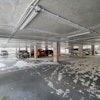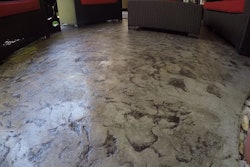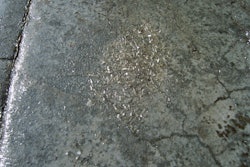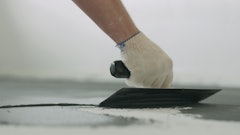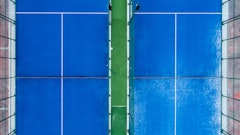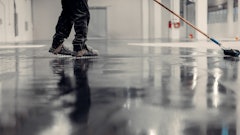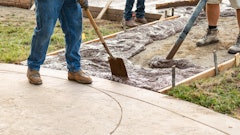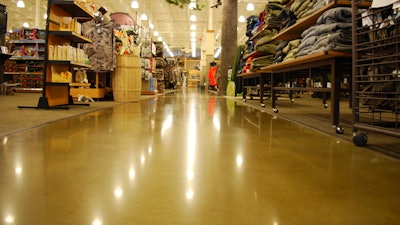
 Greg Cabot, Digital Marketing Manager for AmeripolishAmeripolish
Greg Cabot, Digital Marketing Manager for AmeripolishAmeripolish
Q. Why are there different types of sealers?
A. This is really a two- or three-fold question. First, what kind of protection and what do you want it to look like when you’re done. One of the most important things to the building owner is what the finished product is going to look like. You can choose a matte finish, a satin finish, a glossy finish, or no change at all (meaning that the look of the finished floor will rely entirely on the diamond tooling). Work with your customer to match the environment to a sustainable look. For example, if the customer wants a glossy finish, but they have a super high traffic environment and there are spills all over the place - maybe it’s something like a machine shop where they kind of work on forklifts. Most of these glossy sealers are topical or semi-topical at best and would wear quickly. In a high traffic environment where you want a glossy floor, I would recommend a fully penetrating sealer accompanied with the proper maintenance to that floor.
Also, know what the sealer will do on the floor. Does it penetrate the surface and protect the concrete from within? Does it penetrate a little bit and sit on top to act as a sacrificial coating? Is it entirely a sacrificial coating? The fully penetrating products tend to perform a lot better on stained and abrasion-resistant overlays. Generally, Ameripolish recommends our penetrating sealers for high traffic environments or with floors that are going to see a lot of use. For decorative finishes, with a lot of different colors, we tend to suggest a semi-penetrating / semi-topical sealant so that you can burnish it. It has a glossy look and still has somewhat of a sacrificial coating on the surface. That way you can get some traffic on there. Once a topical starts to wear, it’s time to reapply. It does a good job of protecting what’s underneath it but in a commercial or industrial environment - that’s not your best bet. It’s going to wear out within a few months.
Some are going to perform better than others. For example, in a stain resistance test where you pour pickle juice or vinegar or something acidic on the surface to see how long it takes for it to mar the concrete, some sealers are going to last three or four hours - others 15 minutes. Others even longer than the four-hour mark. It is really dependent on how much water and chemicals are in it. There’s not a one-size-fits-all.
This is why we usually say if you’re going to be in a heavy traffic spill environment you want to go with the fully penetrating just because - across the board, no matter the company – the fully penetrating products do perform better with stain resistance than the semi-tropical or topical products. Because the topical nature of the product makes that sacrificial surface; it's designed to literally be attacked by whatever the spill is so it protects the floor beneath it. That’s what it’s supposed to do. In terms of staining, it’s going to stain significantly easier because it’s actually just doing its job.
Q. What type of questions should contractors ask clients to find out which sealer to use?
A. Great question. Know what your maintenance program will look like. Do you have auto-scrubbers or is it just some mop and bucket situation? Do they have access to auto-scrubber machines? There are maintenance systems out there that can hold those floors up for years if the maintenance program is correct.
Ask what kind of traffic is going to happen. Is it subject to spilling? It’s difficult to say because there are so many variables that go into it. But, really, the main thing is the maintenance program. If you are going to have a reliable maintenance program, you’re better off going with the fully penetrating sealer about 99.9% of the time. I reserve the semi-topical ones for residential or office spaces that only see light traffic and maybe they have a little color on the floor. Topical sealers have a color-enhancing feature to them.
 A fully penetrating sealer as a finished product. Notice the high clarity polish and distinctness of image (DOI) - you can almost read the labels in the reflection.Ameripolish
A fully penetrating sealer as a finished product. Notice the high clarity polish and distinctness of image (DOI) - you can almost read the labels in the reflection.Ameripolish
Q. How do you fix delaminating and flaking? Why do they happen?
A. You fix them by avoiding them. The flaking and delaminating issue is usually because the sealant product is too much of a topical base and it doesn’t breathe. Concrete is a porous and a breathing surface. On a microscope, concrete looks like a sponge, and all these minerals, salts and moisture are actually being pushed out from the bottom of it as it continues to hydrate for the lifetime of the concrete.
Imagine a piece of plastic on a hot cup of coffee. Where all that condensation builds up, all that moisture is trying to push out. If you trap that moisture with a coating, it builds up underneath and starts to bubble. That’s where the delaminating and flaking comes from - eventually that sealer cracks and then it’s just going to start flaking off. You can avoid that by selecting a breathable sealer, designed for polished concrete.
If you do run into a situation where the product is already on the floor and it started to delaminate, it’s the unfortunate case that you have to remove it. There really is no Band-Aid for that situation.
 A close-up look at a breathable sealer on concrete.Ameripolish
A close-up look at a breathable sealer on concrete.Ameripolish
Q. How do breathable sealants work?
A. Long story short, it lays on the pores of the concrete like a Teflon. The sealer just covers the first couple of millimeters of the surface and once a breathable sealant dries, it doesn’t sit on the surface but in the entire pore structure beneath. As moisture and minerals work through, they can still push through the pour structure and get to the surface allowing some air space to breathe and get that moisture in and out.
Our penetrating sealer forms a hydrophobic barrier and an oleophobic barrier. When moisture moves up to where the sealer is, a breathable sealer allows that moisture out. When the moisture dries it should evaporate without issue; 85% 90% of polished concrete floors that we see do not have these issues. In the other 10% where an efflorescence is left behind, it’s because the sealer is allowing it to breathe and be pushed to the surface. If the sealer didn’t allow that, it would cause that flaking and delaminating.
 This white power efflorescence is a tell-tale sign of a moisture issue within the concrete.Ameripolish
This white power efflorescence is a tell-tale sign of a moisture issue within the concrete.Ameripolish
Q. What’s happening in that 10%? How can we avoid efflorescence?
A. In a high-moisture scenario, the minerals that get pushed to the surface create efflorescence – a white dust on the surface – and that becomes an issue. We suggest to use a moisture vapor barrier and to do a calcium Chloride test to make sure that you don’t have a moisture problem in your slab. If you have a moisture problem, even with breathable sealants, that efflorescence could be present. A vapor barrier helps avoid that happening, but it’s not a guarantee. We suggest architects always specify a moisture vapor barrier because they can only help.
Q. What would be your advice to contractors designing a maintenance plan?
A. Work with both the manufacturer of the sealer and the manufacturer of the overlayment system. Try to get them in the same room at the same time. The chemical manufacturer is going to have one recommendation and the overlayment company is going to have theirs because they know what reacts well with their product. We recommend that our contractors hand over some sort of maintenance packet to the floor owner, like, “here’s the floor I installed, this is the maintenance program that goes with it.” If the floor owner follows it, the floor shouldn’t fail.
The contractor has to know what works for their floors. Because like I mentioned with the semi-topical products, there’s a maintenance program for it that works well enough but it is going to require a sealer reapplication. For example, a school where reapplication would be on an annual basis in the entryways. There you’re seeing thousands of kids walk through the door but that front area will wear out first because the dirt on your shoes is like an equivalent to a 200-grit resin tool. It’s just tearing the floor apart just from dirty shoes and it’s going to dull your floor out. That’s when the contractor has to come in, clean up the area, reseal the product, burnish it, pop it out, and feather it in to match the rest of the floor.
In the end, read your concrete. Every slab of concrete is different – even if they are right next to each other. It may be the last thing you apply to the slab, but the sealant on top of a polished concrete floor requires continued attention and that means the right maintenance plan. “The sealer needs to walk hand in hand with the maintenance program,” says Cabot. “If you don’t maintain it properly, it will never work no matter what. Something is going to go astray. The floor is not going to look like you want it if it’s not being maintained properly.”



